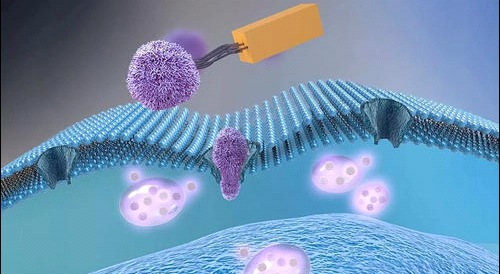文獻:Salivary Cortisol Determination on Smartphone-Based Differential Pulse Voltammetry System
作者:by Jingjing Liu 1,2,3ORCID,Ning Xu 2,Hong Men 2ORCID,Shuang Li 1ORCID,Yanli Lu 1,Sze Shin Low 1,Xin Li 1,Lihang Zhu 1,Chen Cheng 1,Gang Xu 1 andQingjun Liu
文獻鏈接:https://www.mdpi.com/1424-8220/20/5/1422
摘要:
With the accelerated pace of life, non-invasive cortisol detection at the point of care (POC) is in high demand for personal health monitoring. In this paper, an ultrasensitive immunosensor using gold nanoparticles/molybdenum disulfide/gold nanoparticles (AuNPs/MoS2/AuNPs) as transducer was explored for non-invasive salivary cortisol monitoring at POC with the miniaturized differential pulse voltammetry (DPV) system based on a smartphone. Covalent binding of cortisol antibody (CORT-Ab) onto the AuNPs/MoS2/AuNPs transducer was achieved through the self-assembled monolayer of specially designed polyethylene glycol (PEG, SH-PEG-COOH). Non-specific binding was avoided by passivating the surface with ethanolamine. The miniaturized portable DPV system was utilized for human salivary cortisol detection. A series current response of different cortisol concentrations decreased and exhibited a linear range of 0.5–200 nM, the detection limit of 0.11 nM, and high sensitivity of 30 μA M?1 with a regression coefficient of 0.9947. Cortisol was also distinguished successfully from the other substances in saliva. The recovery ratio of spiked human salivary cortisol and the variation of salivary cortisol level during one day indicated the practicability of the immunosensor based on the portable system.

本文探索了一種使用金納米粒子/二硫化鉬/金納米粒子(AuNPs/MoS2/AuNPs)作為傳感器的超靈敏免疫傳感器,用于基于智能手機的小型差分脈沖伏安法(DPV)系統在POC進行非侵入性唾液皮質醇監測。
皮質醇抗體(CORT-Ab)與AuNPs/MoS2/AuNPs傳感器的共價結合是通過特殊設計的聚乙二醇(PEG,SH-PEG-COOH)的自組裝單層實現的。通過用乙醇胺鈍化表面來避免非特異性結合。小型便攜式DPV系統用于人類唾液皮質醇檢測。
不同皮質醇濃度的一系列電流響應降低,線性范圍為0.5-200 nM,檢測限為0.11 nM,靈敏度為30μA M?1,回歸系數為0.9947。皮質醇也成功地與唾液中的其他物質區分開來。加標人唾液皮質醇的回收率和唾液皮質醇水平在一天內的變化表明了基于便攜式系統的免疫傳感器的實用性。
相關推薦:
SH-PEG-HZ
ACA-PEG-SH
SH-PEG-OH
AC-PEG-SH
AlKyne-PEG-SH
MA-PEG-SH
N3-PEG-SH
SH-PEG-Biotin
Fmoc-NH-PEG-SH
SH-PEG-NH2.HCl
SH-PEG-COOH
以上文章內容來源各類期刊或文獻,如有侵權請聯系我們刪除!




 齊岳微信公眾號
齊岳微信公眾號 官方微信
官方微信 庫存查詢
庫存查詢